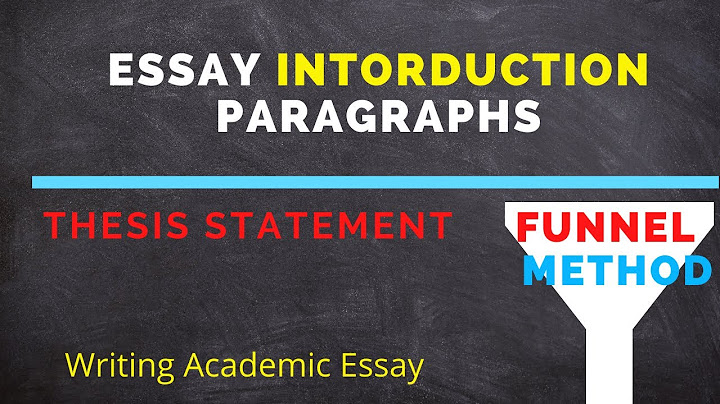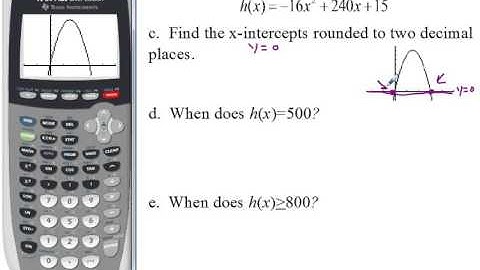Preparing an outlineYou are ready to write an essay after you have done these steps: Show
Most essays follow a similar structure, including an introduction, body paragraphs, and a conclusion, as shown in the diagram below. Click on the plus icons for more information. NoteThere is no set requirement for the number of paragraphs in an essay. The important point is that the argument is logically developed through a series of well-structured paragraphs. Writing an introductionThe purpose of the introduction is to give your reader a clear idea of what your essay will cover. It should provide some background information on the specific problem or issue you are addressing, and should clearly outline your answer. Depending on your faculty or school, ‘your answer’ may be referred to as your position, contention, thesis or main argument. Whatever term is used, this is essentially your response to the essay question, which is based on the research that you have undertaken or the readings you have analysed. An essay is not like a mystery novel which keeps the reader in suspense; it should not slowly reveal the argument to the reader. Instead, the contention and supporting arguments are usually stated in the introduction. When writing an introduction, you should typically use a general to specific structure. This means that you introduce the particular problem or topic the essay will address in a general sense to provide the context before you narrow down to your particular position and line of argument.  Key elements of an introductionClick on each of the elements to reveal more. Sample introduction[1]Business leadership has been described as the ‘ability to influence, motivate and enable others to contribute to the effectiveness and success of the organisations of which they are members’ (House, Hanges, Javidan, Dorfman & Gupta, 2004, p. 63). Whether this ability is something a person is born with, or whether it is something that a person can learn, has been the subject of considerable debate. Kambil (2010) has outlined two categories of leadership attributes that help to frame the discussion: 'traits' (mostly innate) and 'skills' which can be developed through experience or training. [2] This essay will draw on the trait theory of leadership to argue that that leaders are first born, but then must be made. [3] While good business leaders share certain traits that are essential to success, including ‘curiosity, courage, perseverance, personal ethics and confidence’ (Kambil, 2010, p.43), they also need learnable skills, such as communication, negotiation and conflict resolution, that are only developed through practice. A potential leader should develop their natural traits as well as learn and practise skills which will help them to persuade, equip and inspire others to realise their vision. Legend: [1] Background / Context ; [2] Position / Contention ; [3] Structure or main point of essay View Close Check your understanding ViewWriting a body paragraphThe body of the essay is where you fully develop your argument. Each body paragraph should contain one key idea or claim, which is supported by relevant examples and evidence from the body of scholarly work on your topic (i.e. academic books and journal articles). Together, the body paragraphs form the building blocks of your argument. How do I structure paragraphs?The TEECL structure provides an effective way of organising a paragraph. TEECL stands for Topic sentence, Explanation, Evidence, Comment, and Link. You may find it helpful to add C for Comment before Link. A paragraph structured this way would contain the following:
Sample paragraph[1] One of the main obstacles to reaching international consensus on climate change action is the ongoing debate over which countries should shoulder the burden. [2] Because the developed world has historically been responsible for the majority of greenhouse gas emissions, it has been argued that they should reduce emissions and allow developed nations to prioritise development over environmental concerns (Vinuales, 2011). [3] The notion of ‘common but differentiated responsibility’ (CBDR) was formalised in the UN Framework Convention on Climate Change in Rio de Janeiro in 1992 (UNFCCC, 1992). Article 3.1 explicitly states 'Accordingly, the developed country Parties should take the lead in combating climate change and the adverse effects thereof' (p. 4). [4] However, because CBDR outlines a principle and not an actionable plan it has remained problematic. For example, it does not stipulate the extent to which, under the principle of CBDR, developing nations should be exempt from specific emissions targets. This has continued to be a point of contention in global negotiations on climate change, with developed countries such as the USA arguing that developed nations should do more to reduce emissions (Klein et. al., 2017). [5] Fairness and equity need to be pursued in reaching a global agreement on climate change, but transforming this into an actionable strategy is problematic. Legend: [1] Topic sentence [2] Explanation [3] Evidence / Example [4] Comment [5] Link View Close Check your understanding ViewThe function of a conclusion is to draw together the main ideas discussed in the body of the essay. However, a good conclusion does more than that. You may choose to also:
When writing a conclusion, a specific to general structure is usually recommended. Yes, this is opposite to the introduction! Begin by re-stating or re-emphasising your position on the topic, then summarise your line of argument and key points. Finish off by commenting on the significance of the issue, making a prediction about the future of the issue, or a recommendation to deal with the problem at hand.  Sample conclusion[1] No single theory can adequately explain the relationship between age and crime, and the debate over their correlation is ongoing. Instead, each theory provides valuable insight into a particular dimension of age and crime. [2] The emergence of the criminal propensity versus criminal career debate in the 1980s demonstrated the importance of both arguments. It is now believed that the age-crime curve created by Gottfredson and Hirschi is a good basic indicator for the age-crime relationship. However, the criminal career position has stood up to stringent empirical testing, and has formed an integral part of developmental theories such as Thornberry’s interactional theory. [3] These theories provide important insight into the complex relationship between age and crime, but, more than this, are useful for developing strategies for delinquency and crime prevention. Legend: [1] Specific contention ; [2] Specific summary of main points ; [3] Broader and general significance What is a good introduction sentence for an essay?The introductory paragraph of any paper, long or short, should start with a sentence that piques the interest of your readers. In a typical essay, that first sentence leads into two or three more sentences that provide details about your subject or your process. All of these sentences build up to your thesis statement.
How do you start a good introduction?Use a stat or fact to convey importance.. Keep your first sentence short. ... . Say something unusual. ... . Don't repeat the title. ... . Keep the introduction brief. ... . Use the word “you” at least once. ... . Dedicate 1-2 sentences to articulating what the article covers. ... . Dedicate 1-2 sentences to explaining why the article is important.. What are good introduction examples?Strong Introduction Paragraph Examples. Use a Surprising Fact. You can capture the reader's attention with a surprising fact or statement. ... . Pose a Question. ... . Start With an Anecdote. ... . Set the Stage. ... . State Your Point Clearly. ... . Start With Something Shocking. ... . Use a Statistic. ... . Get Personal.. What are the 3 things a good introduction should have?In general, an intro paragraph is going to have three main parts: a hook, context, and a thesis statement. Each of these pieces of the intro plays a key role in acquainting the reader with the topic and purpose of your essay.
|

Related Posts
Advertising
LATEST NEWS
Advertising
Populer
Advertising
About

Copyright © 2024 en.frojeostern Inc.


















